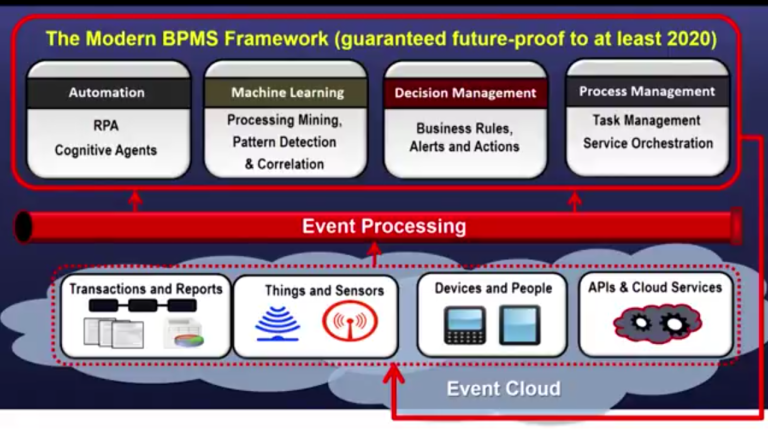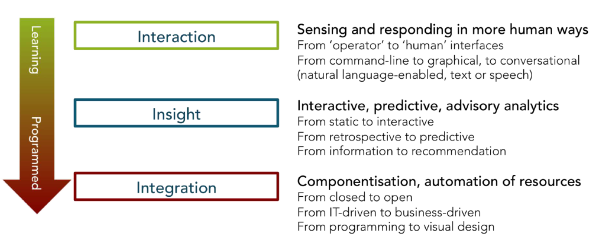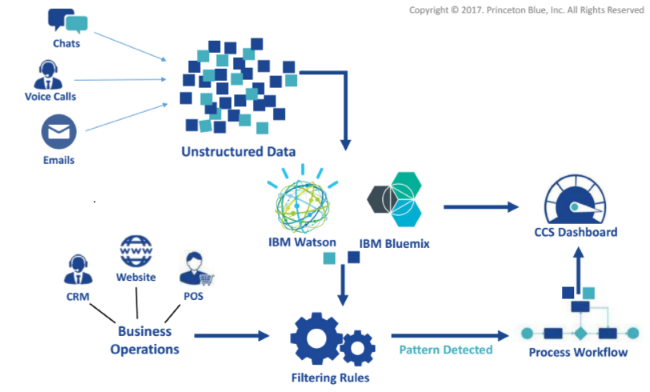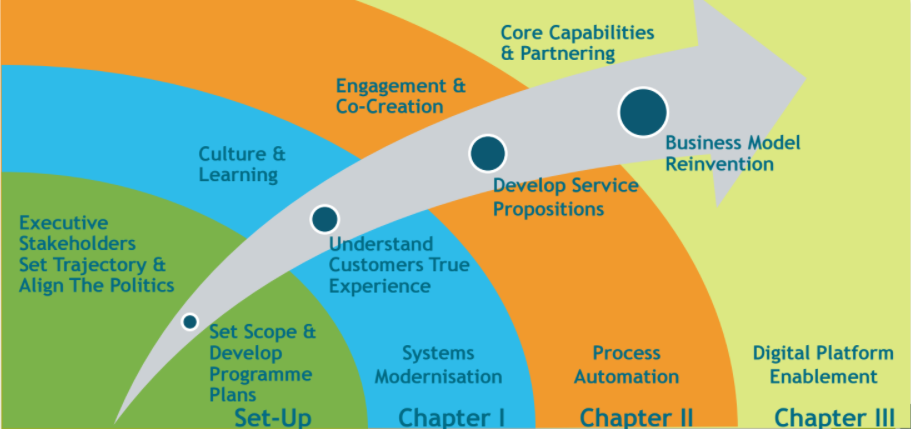Keynotes bpmNEXT 201710th of July 2017 |
 |
Already the fifth installment of the bpmNEXT conference happened this year. As it is organized across the pond in the new world, the logistical problems with me attending proved once again to be too much. Luckily, the organizers are gracious enough to post the keynotes on their website, so that those unfortunate souls not being able to attend, can still sample the content that was presented by such luminaries of the field as Nathaniel Palmer and Jim Sinur. For me, this conference highlights the direction process management is going in the next few years, and what to look out for.
Nathaniel Palmer launched the conference with his keynote, reprising his view on the 3 R’s (Robots, Relationships, and Rules). He revisited his diagram for a BPMS framework from last year (see diagram below), mostly emphasizing the Robotic Process Automation (RPA) as a strong contestant for dominating the process landscape in the coming 5 years, where it will certainly influence the balance between wage arbitration and process automation or BPO. RPA will take over the torch in this regard from the mobile development world. Almost all of keynotes of the conference can be situated in one of the four elements of a modern BPMS, with the majority of them either focusing on the Automation part or on the Decision Management part. And thus I will structure my review of these keynotes around those topics.

Nathaniel Palmer's View on Modern BPMS Framework
Process Automation
Process Automation and specifically RPA as the new digital workforce received a lot of attention during the conference. Robots (mostly software, but could be conceived as hardware too) will be constructed around a goal-oriented strategy. They will be executing tasks to work to a certain goal, as well as have constraints in place to curb their actions. They primarily aim to replace the integration tasks that are done manually today. In order to grasp grasp a bit how to see RPA, the Forrester definition was stated in Kofax’s keynote:
Neil Ward-Dutton (MWD Advisors) builds on this to introduce the three layers of RPA, where he states the evolution of RPA to evolve from automated components to which humans must adapt into automated components (through machine learning for example) that adapt themselves to their environment. He also emphasizes that we are not yet at the point of job automation, or even process automation through robots, but rather still at a task level. The drivers for this evolution are rapidly evolving technologies, business pressures, and a pervasive familiarity with intelligent devices becoming common place.

Neil Ward-Dutton's Three Layers of RPA
Machine Learning
The keynote of Pramod Sachdeva (Princeton Blue) about Cognitive Business struck me as an possible avenue for machine learning where the company can really benefit with automating processes. He identifies the Cognitive Business capability as the system automatically interpreting unstructured data (for example such as phone calls), and routes it through cognitive software and business/filtering rules to determine which process should be triggered. Unstructured data makes up almost 90% of all enterprise data, and thus provides a wealth of untapped information to be mined. He then demoed how the system could detect negative responses from customers to correlate with rules on when to take action. A small diagram was shown on which technologies they leveraged to achieve this. The process workflow was done using IBM Process Manager to stay with the IBM technosphere.

Example Architecture for Cognitive Business
Decision Management
When entering a Decision Management Engine into the mix of you toolbox, it is important to decide which component does what task (either human work, decision engine work or process engine work). Larry Goldberg (Sapiens) proposes the following demarcation:
| Human Tasks | Excel at customer contact – empathy, creativity,... Entering unstructured info into systems. |
| BPMS Tasks | Accurate keying of information, scale repetitive processes, light integration access to legacy systems |
| Decision Management Tasks | Consistent application of business logic that has been externalised, visualised and tested for accuracy. |
Decision Management Notation (DMN) is hailed as the standard to describe these automated decisions. Both Bruce Silver for Trisotech and Eduardo Chiocconi for Oracle presented the tooling of their respective companies to try and show that business people could be writing these rules and getting engaged. The zero-coding promise returns to the lands of BPM. However, both seem to use some 90’s style UX screens, where you click your way to a rule that could have been written in code at a tenth of the time. The standard seems viable, but for now I don’t think business people will be handling the rules and deploying them. And even with the screens and wizards, writing the rules still comes across as a very technical matter. Especially when you add FEEL to the mix.
Side note: Keith Swenson together with several vendors has put together a Technology Compatibility Kit (TCK) for DMN which he freely encourages people to use to ratify their implementation. You can read about it on his blog, and there is the GitHub link containing it.
Process Management
Although this component is the oldest of the four, there are still innovations to be had on this battlefield. Blockchain brings in some new perspectives on transactional integrity and sets up a more trusted exchange. Case Management is further maturing as part of the overall BPM experience. And even some old heartaches of BPMS usage, such as it performance, have been revisited.
Especially with the introduction of Big Data and Micro Services, the number of processes running simultaneously has had its potential significantly increased. Camunda’s Jakob Freund alluded to this in his keynote, where he announced a new product to be released soon, called Camunda TNGP. It is a product to tackle what he coins together as Big Workflow. Triggered by the Tech Blog of Netflix, stating it has rejected existing BPMS solutions as a central orchestration component because of their lack to handle the large load of process instances, Camunda has tried to reinvent their Camunda BPMS with the TNGP prototype already clocking performance gains of a factor of 10. This keynote for me marks the beginning of a movement to bring the Micro Services world and the BPM world closer together, and gets me really exciting to check out their product as soon as it is released.
Case Management came up during the talk of Kris Verlaenen (jBoss jBPM). Still feels a bit unusual to see a jBPM talk not presented by either Joram Barrez or Tom Baeyens, even though they haven’t been part of that team for at least 6 years. A bit disappointed to see that they use a modeling standard different than CMMN, but I like how they try to make the unstructured work a bit less chaotic by introducing phases in which certain tasks happen. Not sure how they want to model tasks that could happen in any phase though. The support for planning of these tasks is also a nice touch. jBPM for me has grown tremendously in maturity during the last 4 years, but I am uncertain about their level of adoption on the work floor.
Another keynote in relation to case management was the talk of Paul Holmes-Higgin (edorasware) who presented Flowable, which is a fork of activiti, and allows for the dynamic insertion of tasks and even subprocesses into process instances as parallel branches. This could be managed, as permissions for this are modeled into the BPMN model on the task level. This extension of process management is reminiscent of the Dynamic/Adaptive Case Management heralded by Keith Swenson. I like the possibility, but wonder if afterwards the modified process could be promoted to a new version of the business process automation. This was not evident in the demo given.
Netxt up on influencing technologies, BlockChain is another new development that seems to have started seeping into the BPM technosphere. Its benefits for BPM are inherited from its overall benefits for any organization: virtual continuity, transparency, resilience, immutability, independency, and self-trust. To me, it plays on two main benefits: It improves transactional integrity, and at the same time, it allows for certain business capabilities to be elevated to be industry-wide instead of enterprise-wide, taking economy-of-scale to the next level (like for example the sharing of customer information between casinos in Vegas to combat cheating).
Change Management
Most of the keynotes were about disrupting technologies, and could in that fashion be easily mapped onto the overview of Nathanial Palmer in the beginning of this article. However, one of the keynotes, namely the one given by Derek Miers (MWD Advisors) broke that mold, and went deeper into how you can make your BPM initiatives or business architecture redesigns a success by making sure that your change management is not neglected, but rather that it plays a pivotal role in your efforts. You need C-level adoption (preferably getting them to believe it is their idea), as well as the support and trust of your operational and business people for the program to be adopted. He uses the following quote by the CIO of Barclays Wealth:
As he puts it, technology has evolved to such an extent that any reasonable demand can be met. Technology is no longer you limiting factor, but it won’t get you the transformation you need just by installing the latest new toy. Your people must be willing to change along with it. He proposes to take this in chapters, with the progression shown in the diagram below. An elaboration of each of the chapters can be found by clicking on the respective chapter.

Business Transformation Journey
I spotted some overlap with the ValIT framework of COBIT from this keynote though, when he goes to propose a double need for business transformation: Doing the Right Things, and Doing Things Right. All in all, I found this to be a great reminder of how we need to approach BPM initiatives, that is to look at integrating the disruptive technologies, but never lose sight of the people that need to be on board with using these new capabilities.
| Review | BPM |